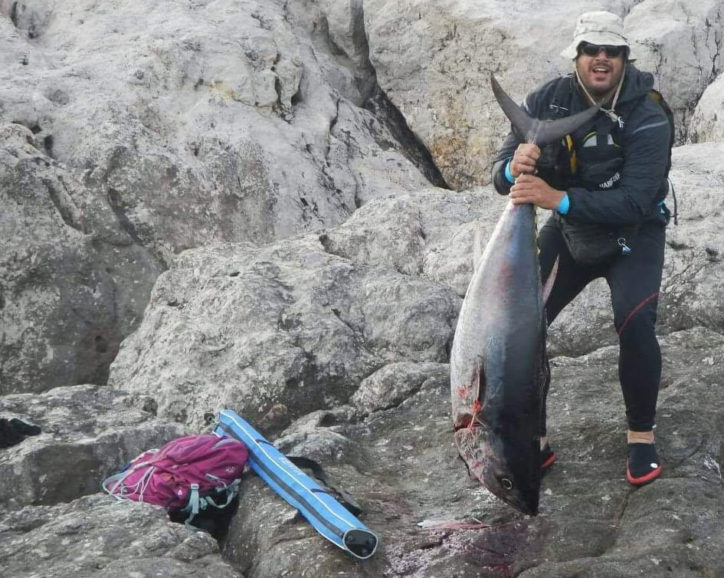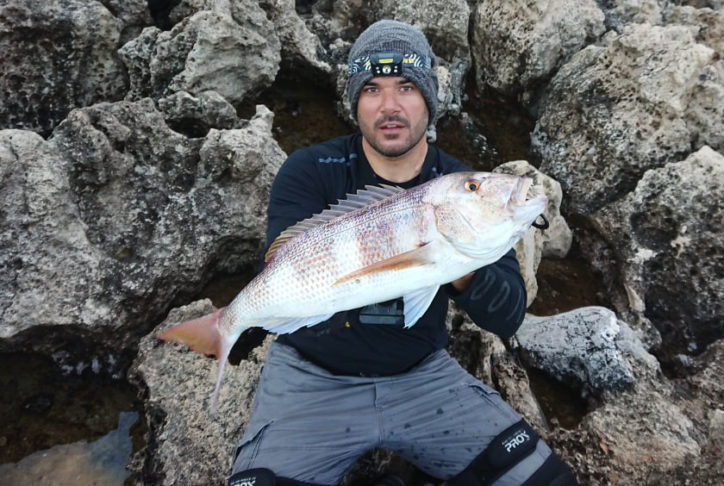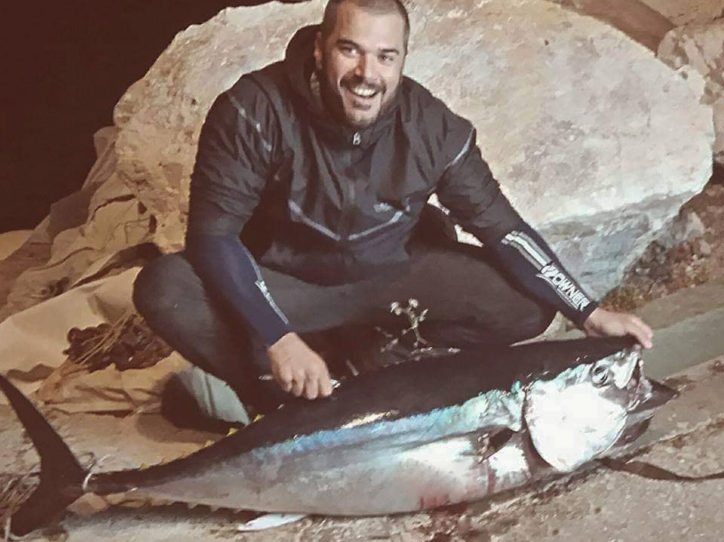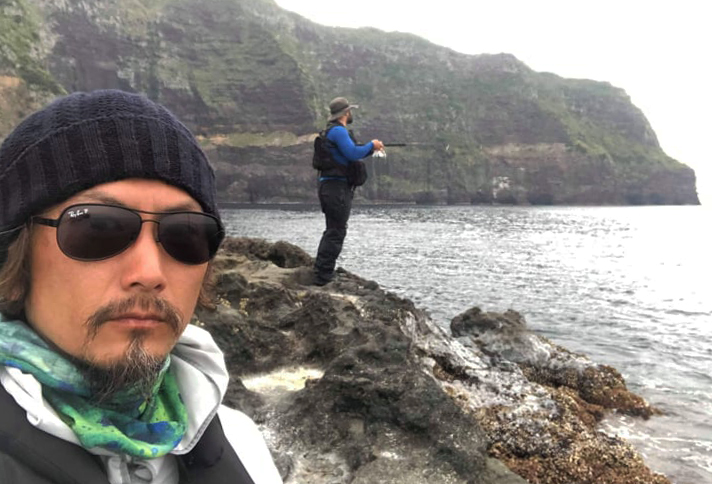Like it or not, nowadays, fishermen get involved in the life of various social networks to a certain degree. Recently, they’ve got used to sharing news concerning fishing, opinions on various fishing techniques, manufacturers’ novelty products and discussing them. Involuntarily, one starts to follow the success and, sometimes, failures of a certain fisherman.
It so happens that adriaticnature has long and mutually been friends with an amazing Greek angler and a great man Panagiotis Kimouris, who adores Shore Jigging – fishing with jigs from the shore. Panagiotis catches rather large fish, often travels to Japan to exchange experiences with Japanese anglers who fish with spinning rods, and is always eager to communicate, and we appreciate it. adriaticnature decided to ask Panagiotis a few questions regarding tactics and strategy of fishing with the use of the shore jigging technique.

(Panagiotis Kimouris. Photo © Panagiotis Kimouris)
– Hello, Panagiotis! Thanks for taking the time to have a conversation with us. I would like to discuss with you the tactics of an angler who uses spinning rods and came to the seashore hoping to catch large fish with a jig. What should the angler start with before going to an unknown shore? What do you do in such cases?
Thanks for taking the time to talk to me, it’s a great pleasure for me to have the opportunity to share my thoughts on fishing on the adriaticnature pages, especially as regards issues of the shore jigging technique – our shared interest.
Preparation for a fishing expedition depends on how much time you plan to spend fishing on the rocks – a whole day or a half-day? Maybe a couple of days, or maybe a week? And the preparation begins with ensuring comfortable conditions for staying at the shore, including food, water, a place to sleep, if that’s your plan, a compulsory first-aid kit, batteries for telephones, flashlights, and other devices and so on. There’s another important thing: your family and friends should know exactly where you are going to spend time, in case something goes wrong.
As for my fishing tackle, I always have two sets: there are a “heavy” one and the one for medium-weight lures. The “heavy” set is intended for fishing with jigs and other types of lures weighing 60 to 150 grams, the other lighter set is for lures weighing up to 40 grams.

(Atlantic bonito caught on a metal jig from the shore. Photo © Panagiotis Kimouris)
– Tell us, please, under what conditions and in what places would you not use jigs when fishing, without considering ultralight and light fishing?
I fish with jigs almost everywhere, regardless of depth and other conditions. A wide choice of metal jigs today enables us to choose the right lure for any situation.
– In turn, are there perfect places and conditions for shore jigging? How do you see them?
I really like fishing in places where the water is deep and when it’s windy, but it doesn’t mean that you can’t succeed in fishing with jigs in rather shallow areas and when there’s almost no wind.
As for me, the perfect place for shore jigging is the cliffs, which are rarely visited by my colleagues. There should be depths from 25-35 meters at a casting distance, and the bottom should be covered with stones.
– Should pelagic jigging be separated from “classic” one (“jigging from the bottom”)? Should these techniques be approached differently in terms of tackle and lures?
You know, it all depends on the goals that the fisherman sets. For example, there’s no need to reinvent the wheel if you want to catch amberjacks from the shore. The classic set of the tackle of the “shore jigger” will enable you to accomplish a bite and take a picture with a trophy, if you avoid making unfortunate mistakes, of course. It doesn’t matter whether you catch fish “from the bottom” or not.
But if you go to the seashore expecting to catch a bluefin tuna, the question sounds different in such a situation. You plan to catch fish weighing more than 40-50 kilograms. So, first and foremost, you need to pay attention to the tackle. High-efficiency fishing with parabolic rods, reels that hold at least 500 meters of braid 5-6 PE thick on a spool, the shock leader with a diameter from 0.6 – 0.7 mm. In this case, it doesn’t really matter whether the bite occurs at the bottom or at the surface.

(Bluefin tuna caught on a metal jig from the shore. Photo © Panagiotis Kimouris)
– Suppose the perfect place for shore jigging is found. What jigs should one start fish scouting with?
Everything will depend on many conditions, there is no simple answer. Currents, depths, degree of water transparency, sunrise, sunset. The sea requires us to observe all the smallest details. Under perfect conditions, I would start fish scouting with jigs painted with natural colors – “blue sardine”, “blue-pink sardine” and so on, of middleweights and a “semi-long” type.
– How often do you change jigs during fishing? What do you pay attention to first of all? Shape, weight, color?
I rarely change jigs during fishing. I always keep in mind that each of them, maybe of a similar shape, has been rather efficient until recently. I always care more about how a certain jig falls during pauses.
– Is it worth experimenting with the speed of retrieve and animation of lures? Or, on the contrary, does it make sense to choose a golden mean and wait for the predator to lose its temper and grab the jig?
It’s great if you have experience in some moves, that you tested before. You just keep on using the same efficient retrieve techniques. However, we should keep in mind that experiments always lead to unexpected pleasant results. We, anglers, are still learning and improving our techniques, as fish do learning of our methods also.
– Pelagic predators may appear in front of the fisherman anytime. But one can and probably should hold out hope for catching nonmigratory predators, such as groupers and dentexes while fishing in the same “perfect place”. Andthe same goes for amberjacks that are still not as actively moving as tuna. How can fishermen understand whether they do everything right, if a sufficient amount of time has passed, and there are still no bites? And how much time should be spent on studying a potential “spot” that is good for fishing? 30 minutes? Predawn hours? The whole day? A week? What is your opinion on this issue?
I try to catch bottom predators, and I try to find fish in the lower layers of water. The search for predators is very successful at the point of maximum high tide and the point of maximum low tide, as well as before dawn. However, it is important, very important, to know at what time of the year one or another predator is active. Moreover, it is important to know other features in the behavior of fish. Therefore, after your fishing, always record the conditions during which the fishing took place. Moon phases, tides and flows, wind direction and so on.

(Common dentex caught on a metal jig from the shore. Photo © Panagiotis Kimouris)
– Getting back to the animation of jigs – are there “specialized” options for different fish species? If so, could you give some examples?
I caught a large number of different fish species with the same jigs. And I’m sure that it’s much more important to know what the predators prey on at a certain time and in a certain place. For example, on garfishes or sardines.
– How often do you use the so-called Shore Slow in your fishing practice? In what cases?
Of course, I use it. It depends on the water temperature, as well as on the activity of the fish, in general.
– Should fans of shore jigging, who like to catch predators in the Mediterranean area, give up on fishing in the height of summer? You will probably agree that the off-season and winter months are more favorable for catching interesting fish, won’t you?
No way! Early morning and late evening of a hot summer in July and August, for example, are my favorite time for catching dentex. However, my favorite time for searching for amberjacks is spring and autumn – October and November. However, June can be a great month to catch them. Don’t be lazy, cast jigs into the water all year-round.

(Yellowtail amberjack (kingfish) caught on a metal jig from the shore. Photo © Panagiotis Kimouris)
– If an angler expects to catch a trophy, which minimum characteristics should a rod, reel, cord and shock leader have, in your opinion?
I can’t answer this question unambiguously. After all, the concept of “trophy fish” is very blurry. It can be a large dentex, a well-fed grouper, amberjack, a little tunny, or maybe a bluefin tuna. Relatively light sets are enough for catching some of them, others require using only heavy and high efficient “sets”.
– To the anglers’ deep regret, catching bluefin tuna is banned in Greece, but there are Mediterranean countries where it is legal. Tuna caught from the shore is probably the most coveted trophy of many anglers who are fond of shore jigging. Tell us, what should one know and how can one get closer to catching this great fighter?
Indeed, unfortunately, catching bluefin tuna has recently been banned in Greece. If it attacks your lure, and you pull it out ashore, then the only legitimate further action is to release it into its native habitat. What is required for catching the “bluefin”? First of all – Patience. But you need proper tackle as well. You need to have reels that can meet the powerful resistance of fish and can withstand high temperatures during the fight-backs of the predators. The knots should be checked and carefully tied. And you should have a high efficient parabolic rod, which can withstand a load of at least 7+ kilograms at an angle of 45 degrees.

(Bluefin tuna caught on a metal jig from the shore. Photo © Panagiotis Kimouris)
As for jigs. In my opinion, bluefin tuna responds best to jigs painted with colors resembling the color of sardines. For instance, “blue”, “blue pink”. The type of jigs may be “long” or “semi-long”. Large tuna often preys near the surface. Large tuna can easily hunt for its prey near the bottom or under the surface as well. Remember to explore all possible horizons.
As for the weights and sizes of jigs. Long jigs weighing about 100 grams – I would try to induce a bite of tuna using them. But it doesn’t mean that the “bluefin” won’t be tempted and won’t attack a jig weighing 30 grams. Again, the size of the lure should correspond to the size of the target of a predator.
– Lately, you’ve been spending a lot of time in Japan. You are actively fishing with professional local professional anglers who use spinning rods. Moreover, currently, you introduce yourself as “A Greek angler in Japan” on your Facebook page. What attracts you the most in the Land of the Rising Sun?
I dream about visiting Japan since my childhood. Japan is a very beautiful country with kind and friendly people. I also have good friends there whom I love and respect a lot. I want to thank especially, Master Taro Matsumoto-San, the product director of APIA – Anglers Utopia, who gave me that opportunity!

(Shore jigging in Japan with Taro Matsumoto-San. Photo © Panagiotis Kimouris)
– What would you wish the adriaticnature readers?
Fishing is a way to escape from our problems, so keep fishing and have fun, and do not ever give up because your dream is somewhere out there!